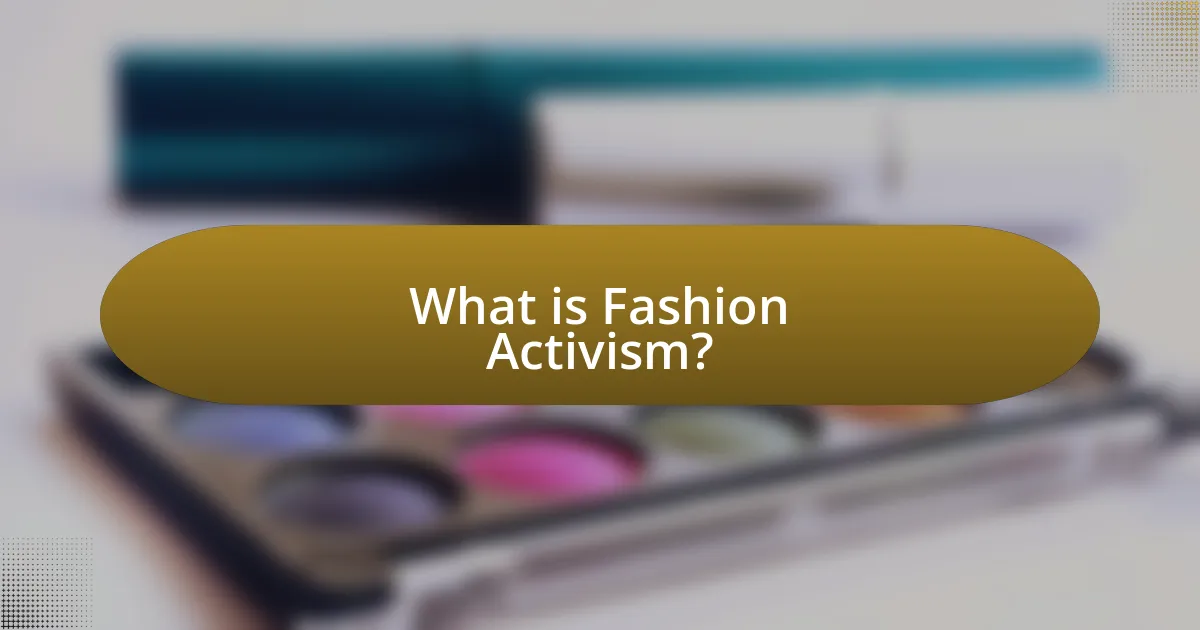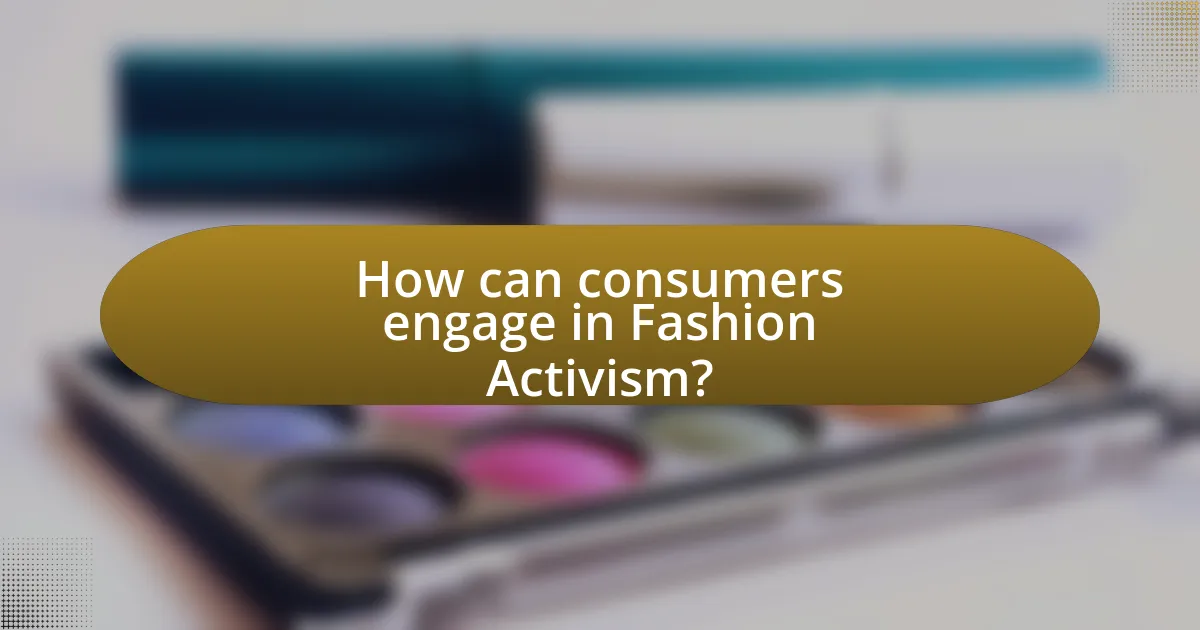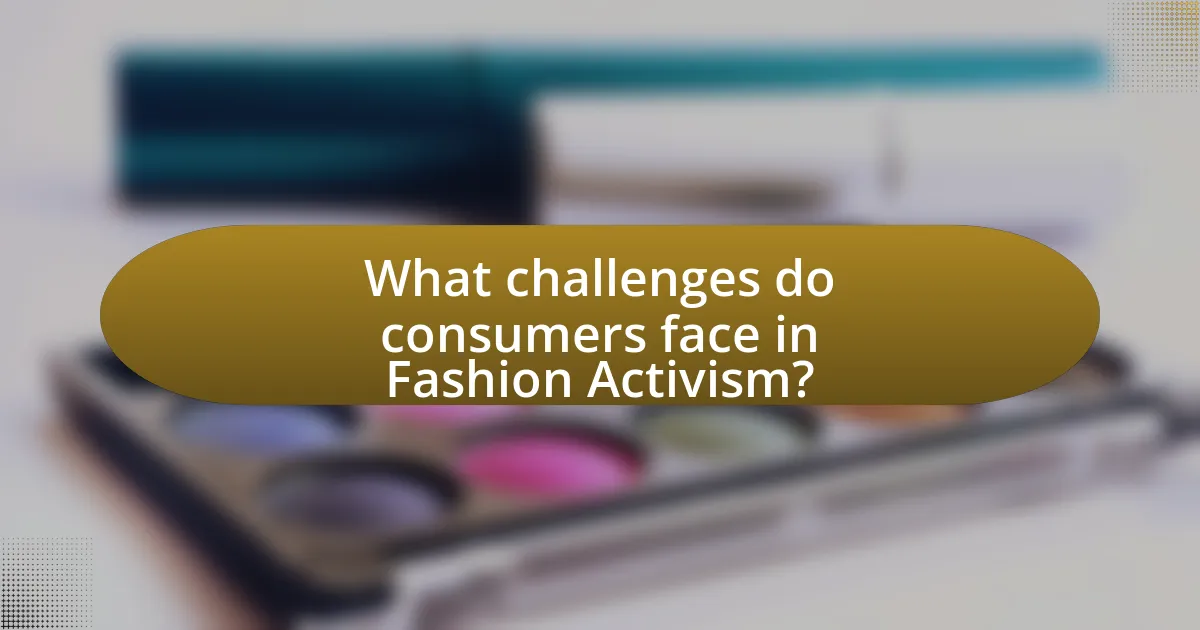Fashion activism is the movement that utilizes fashion as a means to advocate for social, environmental, and political change, emphasizing ethical practices, sustainability, and inclusivity within the industry. This article explores how fashion activism influences consumer behavior and industry standards, highlighting key principles such as transparency and ethical production. It discusses the role of consumers in driving change through informed purchasing decisions and advocacy, while also addressing the challenges they face, including greenwashing and limited access to sustainable options. Additionally, the article outlines practical steps consumers can take to promote responsible consumerism and engage in effective activism within the fashion sector.

What is Fashion Activism?
Fashion activism is the use of fashion as a platform to promote social, environmental, and political change. This movement seeks to challenge the traditional fashion industry by advocating for ethical practices, sustainability, and inclusivity. For instance, brands like Patagonia and Stella McCartney have integrated activism into their business models, emphasizing eco-friendly materials and fair labor practices, which highlights the growing consumer demand for responsible fashion.
How does Fashion Activism influence the fashion industry?
Fashion activism significantly influences the fashion industry by promoting ethical practices and sustainability. Activists advocate for transparency in supply chains, pushing brands to adopt fair labor practices and environmentally friendly materials. For instance, the Fashion Revolution movement, which began in response to the Rana Plaza disaster in 2013, has raised awareness about the human and environmental costs of fast fashion, leading to increased consumer demand for sustainable options. This shift has prompted major brands like H&M and Zara to commit to more sustainable practices, such as using organic cotton and reducing waste. Consequently, fashion activism not only shapes consumer preferences but also compels brands to evolve their business models to align with ethical standards.
What are the key principles of Fashion Activism?
The key principles of Fashion Activism include sustainability, ethical production, inclusivity, and transparency. Sustainability emphasizes reducing environmental impact through eco-friendly materials and practices. Ethical production focuses on fair labor practices and humane working conditions for garment workers. Inclusivity advocates for diversity in fashion representation, ensuring that all body types, ethnicities, and genders are represented. Transparency involves brands openly sharing their supply chain practices and sourcing information, allowing consumers to make informed choices. These principles collectively aim to create a more responsible and equitable fashion industry.
How does Fashion Activism differ from traditional activism?
Fashion activism differs from traditional activism primarily in its focus on the fashion industry as a platform for social change. While traditional activism often addresses broad social, political, or environmental issues through various means such as protests or policy advocacy, fashion activism specifically leverages clothing, design, and consumer behavior to promote awareness and drive change within the fashion sector. For instance, fashion activists may use sustainable materials or ethical production practices to highlight issues like labor rights or environmental sustainability, directly influencing consumer choices and industry standards. This targeted approach allows fashion activism to engage consumers in a unique way, making them active participants in the movement through their purchasing decisions.
Why is Fashion Activism important for consumers?
Fashion activism is important for consumers because it empowers them to influence ethical practices within the fashion industry. By advocating for sustainable and fair labor practices, consumers can drive brands to adopt more responsible production methods. For instance, a 2021 report by McKinsey & Company highlighted that 67% of consumers consider sustainability when making a purchase, indicating a significant demand for ethical fashion. This consumer pressure encourages brands to prioritize transparency and accountability, ultimately leading to a more sustainable industry.
What role do consumers play in driving Fashion Activism?
Consumers play a crucial role in driving Fashion Activism by influencing brands through their purchasing decisions and advocacy for ethical practices. When consumers prioritize sustainable and ethically produced fashion, they create demand for transparency and accountability in the industry. For instance, a 2021 survey by McKinsey & Company found that 67% of consumers consider sustainability when making a purchase, demonstrating that consumer preferences can compel brands to adopt more responsible practices. Additionally, social media platforms amplify consumer voices, allowing individuals to mobilize support for causes such as fair labor practices and environmental sustainability, further pressuring brands to align with these values.
How can consumer choices impact the fashion supply chain?
Consumer choices significantly impact the fashion supply chain by influencing production practices, resource allocation, and sustainability efforts. When consumers prioritize ethical and sustainable brands, companies are compelled to adopt more responsible sourcing and manufacturing processes to meet this demand. For instance, a 2021 report by McKinsey & Company found that 67% of consumers consider the use of sustainable materials important when making fashion purchases, prompting brands to invest in eco-friendly materials and practices. Additionally, consumer preferences for transparency and ethical labor practices have led to increased scrutiny of supply chains, encouraging brands to disclose their sourcing and labor conditions. This shift in consumer behavior not only drives brands to improve their practices but also fosters a more sustainable and ethical fashion industry overall.

How can consumers engage in Fashion Activism?
Consumers can engage in Fashion Activism by making conscious purchasing decisions that prioritize ethical brands and sustainable practices. By choosing to buy from companies that demonstrate transparency in their supply chains and commit to fair labor practices, consumers can influence the fashion industry to adopt more responsible behaviors. For instance, a 2021 report by the Fashion Transparency Index found that only 40% of brands disclose their suppliers, highlighting the need for consumer demand for transparency. Additionally, consumers can participate in advocacy campaigns, support second-hand shopping, and promote awareness of the environmental impacts of fast fashion, thereby driving change in industry standards and practices.
What are effective strategies for consumers to promote Fashion Activism?
Effective strategies for consumers to promote Fashion Activism include supporting sustainable brands, advocating for ethical labor practices, and participating in awareness campaigns. By choosing to purchase from brands that prioritize eco-friendly materials and fair labor conditions, consumers can directly influence the market towards more responsible practices. Research indicates that 66% of global consumers are willing to pay more for sustainable brands, demonstrating a clear demand for ethical fashion. Additionally, consumers can engage in social media campaigns to raise awareness about issues like fast fashion’s environmental impact, further amplifying the message of Fashion Activism.
How can consumers support sustainable fashion brands?
Consumers can support sustainable fashion brands by choosing to purchase from companies that prioritize eco-friendly materials, ethical labor practices, and transparent supply chains. By actively seeking out brands that demonstrate a commitment to sustainability, consumers can drive demand for responsible practices in the fashion industry. Research indicates that the global sustainable fashion market is projected to reach $8.25 billion by 2023, highlighting the growing consumer interest in ethical fashion choices. Additionally, consumers can engage in practices such as buying second-hand clothing, participating in clothing swaps, and advocating for sustainable policies, further amplifying their impact on the industry.
What actions can consumers take to raise awareness about ethical fashion?
Consumers can raise awareness about ethical fashion by actively engaging in discussions on social media platforms. By sharing information, personal experiences, and resources related to ethical brands and sustainable practices, consumers can influence their peers and broaden the conversation around ethical fashion. Research indicates that social media campaigns can significantly increase awareness and consumer interest in sustainable fashion, as seen in the #WhoMadeMyClothes movement, which highlighted labor rights in the fashion industry. Additionally, consumers can participate in or organize local events, such as clothing swaps or workshops, to educate others about the importance of ethical fashion choices. These actions not only promote awareness but also foster community engagement and support for sustainable practices.
Why should consumers educate themselves about Fashion Activism?
Consumers should educate themselves about Fashion Activism to understand their role in promoting ethical practices within the fashion industry. By being informed, consumers can make conscious purchasing decisions that support sustainable brands and challenge exploitative practices. For instance, the fashion industry is responsible for 10% of global carbon emissions and significant water pollution, highlighting the urgent need for change. Educating themselves enables consumers to advocate for transparency, support fair labor practices, and reduce environmental impact, ultimately driving systemic change in the industry.
What resources are available for learning about ethical fashion practices?
Resources for learning about ethical fashion practices include online courses, books, documentaries, and websites dedicated to sustainable fashion. For instance, platforms like Coursera and edX offer courses on sustainable fashion, while books such as “Fashionopolis” by Dana Thomas provide insights into the industry. Documentaries like “The True Cost” highlight the impact of fast fashion and promote awareness. Websites such as Fashion Revolution and Good On You provide valuable information and resources for consumers seeking to make ethical choices in fashion. These resources collectively enhance understanding and encourage responsible consumer behavior in the fashion industry.
How can knowledge of Fashion Activism empower consumers?
Knowledge of Fashion Activism empowers consumers by equipping them with the understanding of ethical practices and sustainable choices in the fashion industry. This awareness enables consumers to make informed purchasing decisions that align with their values, such as supporting brands that prioritize fair labor practices and environmentally friendly materials. For instance, a study by the Fashion Institute of Technology found that 66% of consumers are willing to pay more for sustainable brands, demonstrating that informed consumers can drive demand for ethical fashion. By leveraging their knowledge, consumers can influence market trends and hold brands accountable for their practices, ultimately fostering a more responsible and transparent fashion industry.

What challenges do consumers face in Fashion Activism?
Consumers face several challenges in Fashion Activism, primarily including a lack of transparency in supply chains, limited access to sustainable options, and the prevalence of greenwashing. The lack of transparency makes it difficult for consumers to identify which brands genuinely adhere to ethical practices, as many companies do not disclose their sourcing and production methods. Limited access to sustainable options restricts consumers’ ability to make informed choices, particularly in regions where eco-friendly products are scarce or overpriced. Additionally, greenwashing complicates the decision-making process, as brands may falsely promote themselves as sustainable to attract conscious consumers, leading to confusion and mistrust. These challenges hinder consumers’ efforts to drive meaningful change in the fashion industry.
What barriers exist for consumers wanting to engage in Fashion Activism?
Consumers face several barriers when wanting to engage in Fashion Activism, including lack of awareness, limited access to sustainable options, and financial constraints. Many consumers are unaware of the environmental and social issues within the fashion industry, which hinders their motivation to participate in activism. Additionally, sustainable fashion options are often not readily available in mainstream retail, making it difficult for consumers to make ethical choices. Financial constraints also play a significant role, as sustainable fashion items typically come at a higher price point, limiting access for budget-conscious consumers. These barriers collectively impede consumer engagement in Fashion Activism.
How do marketing practices affect consumer perceptions of ethical fashion?
Marketing practices significantly shape consumer perceptions of ethical fashion by highlighting transparency, sustainability, and social responsibility. Effective marketing strategies, such as storytelling and influencer partnerships, create emotional connections that resonate with consumers’ values. For instance, brands that share their supply chain practices and environmental impact data tend to foster trust and loyalty among consumers, as evidenced by a 2021 study published in the Journal of Business Research, which found that 70% of consumers are more likely to purchase from brands that demonstrate ethical practices. This alignment between marketing messages and consumer values enhances the perceived credibility of ethical fashion, ultimately influencing purchasing decisions and encouraging a shift towards more sustainable consumption patterns.
What misconceptions about Fashion Activism hinder consumer participation?
Misconceptions about Fashion Activism that hinder consumer participation include the belief that it is only for the wealthy or that it requires significant time and effort. Many consumers think that engaging in fashion activism necessitates a high financial investment, which is not true; even small, conscious purchasing decisions can contribute to change. Additionally, the perception that activism demands extensive knowledge or commitment can deter participation, whereas many impactful actions can be simple and accessible, such as supporting sustainable brands or advocating for ethical practices. These misconceptions limit broader consumer involvement, which is essential for driving meaningful change in the fashion industry.
How can consumers overcome these challenges?
Consumers can overcome challenges in fashion activism by actively choosing sustainable brands and advocating for ethical practices. By researching and supporting companies that prioritize environmental and social responsibility, consumers can influence market demand. For instance, a 2021 report by McKinsey & Company found that 67% of consumers consider sustainability when making purchasing decisions, demonstrating that consumer choices can drive brands to adopt better practices. Additionally, participating in campaigns, signing petitions, and using social media to raise awareness can amplify their voices and encourage industry-wide change.
What community resources can support consumers in their activism efforts?
Community resources that can support consumers in their activism efforts include local advocacy groups, online platforms for organizing, educational workshops, and social media networks. Local advocacy groups often provide resources such as training, networking opportunities, and access to campaigns that align with consumer interests in fashion activism. Online platforms like Change.org enable consumers to create and sign petitions, amplifying their voices on critical issues. Educational workshops offered by organizations focused on sustainable fashion teach consumers about ethical practices and how to advocate for change effectively. Social media networks serve as powerful tools for mobilizing support, sharing information, and connecting with like-minded individuals, thereby enhancing the impact of activism efforts in the fashion industry.
How can collaboration among consumers enhance Fashion Activism?
Collaboration among consumers can enhance Fashion Activism by creating a unified voice that amplifies demands for ethical practices and sustainable fashion. When consumers join forces, they can organize campaigns, share information, and mobilize resources more effectively, leading to greater visibility and impact. For instance, collective actions such as petitions or social media movements can pressure brands to adopt more responsible practices, as seen in the #WhoMadeMyClothes campaign, which raised awareness about labor conditions in the fashion industry. This collaborative approach not only fosters community engagement but also drives accountability among brands, ultimately leading to systemic change in the industry.
What practical steps can consumers take to drive change in the fashion industry?
Consumers can drive change in the fashion industry by prioritizing sustainable brands, advocating for transparency, and reducing consumption. By choosing to purchase from companies that utilize eco-friendly materials and ethical labor practices, consumers support a market shift towards sustainability. Research indicates that 66% of global consumers are willing to pay more for sustainable brands, demonstrating a demand for responsible fashion. Additionally, consumers can advocate for transparency by demanding information about supply chains and production processes, which encourages brands to adopt more ethical practices. Finally, reducing consumption through practices like buying second-hand or participating in clothing swaps minimizes waste and promotes a circular economy, further influencing the industry towards sustainable practices.
How can consumers effectively advocate for policy changes in fashion?
Consumers can effectively advocate for policy changes in fashion by organizing collective actions, such as petitions and campaigns, to raise awareness and influence decision-makers. For instance, the Fashion Revolution movement encourages consumers to demand transparency from brands regarding their supply chains, which has led to increased public pressure on companies to adopt sustainable practices. Additionally, consumers can leverage social media platforms to amplify their voices, share information about unethical practices, and mobilize support for legislative changes. Research indicates that consumer activism can significantly impact corporate policies, as seen in the 2013 Rana Plaza disaster, which prompted global calls for improved labor standards in the fashion industry.
What are the best practices for responsible consumerism in fashion?
The best practices for responsible consumerism in fashion include prioritizing sustainable brands, reducing consumption, and supporting ethical labor practices. Sustainable brands often use eco-friendly materials and transparent supply chains, which contribute to environmental conservation. Reducing consumption can be achieved by buying fewer, higher-quality items that last longer, thereby minimizing waste. Supporting ethical labor practices involves choosing brands that ensure fair wages and safe working conditions for their workers. According to a 2021 report by the Fashion Transparency Index, only 40% of major fashion brands disclose their suppliers, highlighting the importance of consumer awareness in driving demand for transparency and ethical practices in the industry.

Leave a Reply